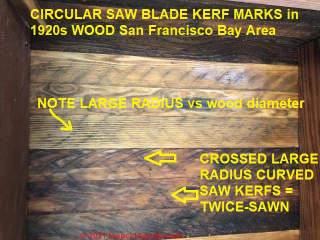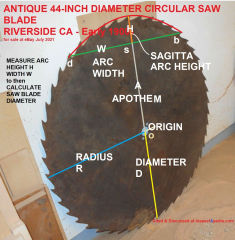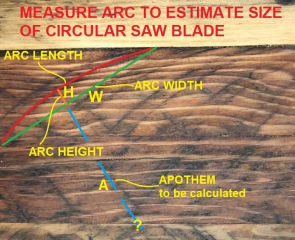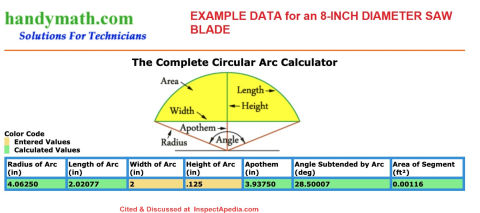 Calculate Diameter of a Circle from its Arc
Calculate Diameter of a Circle from its Arc
Arc width & height give size of a circle or of a circular saw blade: a clue to lumber age
- POST a QUESTION or COMMENT about calculating circle diameter, radius, arc height, arc width for finding size of an antique saw blade
This article describes simple calculations that let us find the size of the circular saw blade that left rounded saw blade marks or "arcs" on a section of wood or other material.
We explain the use of arc and chord measurements, the sagitta and the apothem and we use first an online calculator to find the apothem then radius and then diameter, and then next we use a direct simple algebraic calculation along with the intersecting chord theory to find the diameter of our saw blade.
InspectAPedia tolerates no conflicts of interest. We have no relationship with advertisers, products, or services discussed at this website.
- Daniel Friedman, Publisher/Editor/Author - See WHO ARE WE?
How Calculate the Diameter of the Saw Blade that Made a Curved or Arced Saw Mark
 How old is that house? No idea? Well how old is that sawn wooden board or beam? Let's look at tool marks as an aid to answering those questions.
How old is that house? No idea? Well how old is that sawn wooden board or beam? Let's look at tool marks as an aid to answering those questions.
Once you measure the width and height of the arc mark left by saw blade mark on wood you can easily find the diameter of the circular saw blade that milled that wooden board or beam.
Knowing the size of the circular saw blade that cut the lumber can give us a clue to when the lumber was sawn - a guess at its age and perhaps a help at guessing the age of a building.
Our photo above shows a 44-inch diameter saw blade dating from the early 1900s, for sale on ebay (July 2021) by a vendor in Riverside California.
[Click to enlarge any image]
Summarizing the circle diameter calculation procedure, we simply:
- Measure
the saw cut mark arc chord horizontal width W and height H
Tip: Choosing the longest practical arc width will give the most-accurate results, but using the trick of moving your ruler until you have an arc width W of exactly 2" and then measuring the arc height H at that point makes the math easiest. - Use an online calculator to find the apothem
The Apothem A is the missing length that, when added to arc height H gives us the radius R of the circle.
It's easiest to use an online calculator to find the apothem. At the calculator you simply plug in the arc H and W.
We use The Complete Circular Arc Calculator, found at https://www.handymath.com/cgi-bin/arc18.cgi?submit=Entry
Add the apothem A to the arc height H to get the radius R of the circle, and finally,
Double the radius to get the saw blade diameter D.
Example: if W = 2” & H = .125”, the calculator tells us the Apothem is ~3.9.
We add the Apothem to H to get R. If R, radius is ~4”, then our saw blade diameter D is ~8”.
OR alternatively - Alternative Method: Use simple algebra:
With the measurements from step 1, we can use the Intersecting Chord Theorem and simple algebra to calculate the circle or saw blade diameter.
The details of this approach are in a separate article found
at SAW BLADE MARKS to SAW SIZE CALCULATION ICT
What follows is a more-detailed step-by-step description of what we outlined just above.
First: Measure circular saw kerf mark arc width and height
 How to Measure Saw Cut Marks H & W
How to Measure Saw Cut Marks H & W
It doesn’t matter how long an arc width you measure, because it’s the ratio of the arc width & height that matters, and that ratio is the same for any arc width.
- Use a ruler to choose or measure an arc width W
rIf you're clever, for any arced circular saw kerf mark that's big enough, choose an arc width W that's a convenient number, say 2", and slide your ruler until you've found where that 2-inch line just touches the arc at two points.
See ARC WIDTH W in the illustration.) - Measure the arc height H.
Now at 1" along your 2-inch W line you'll be at the center of that arc segment.
And your H line will indeed head towards the origin of the circle formed by the circular saw blade.
If your arc width W is some other size, then using your ruler find the center of line W and draw your line perpendicular to W up until it touches the red arc of the saw blade cut mark and
Saw Cut Arc Measurement Example
For the old saw cut mark photo used as an example here we didn't have any actual dimensions, just a photo with no scale.
So for this example we are going to make up measurements for H and W.
As Shelly Weinberg taught in algorithm design and queuing theory at IBM's System's Research Institute: Shelly would say:
Don't know the number? No problem! We'll just make some numbers up to test the rule!
We sat in the classroom and stared, like mute idiots, at Shelly. Nobody said a word. Weinberg continued: Hah! Can't think of a number? Make one up!
For our "made-up" example the width of our arced saw kerf mark on our old wood is 2" and we chose a height of the arc of 1/8" (0.125")
W = 2
H = 0.125
H in these drawings is also called the Sagitta.
W in these drawings is the chord length d-b of the arc d-c-b shown in our next sketch below.
Watch out: don't get led astray by the difference between W the width of an arc chord (the green line d-s-b in our sketch) and the length of the curved arc line itself (the red arc d-c-b in our sketch).
Our calculations use H and W and seek A - we do not need and do not measure and do not care about the length along the curved arc line d-c-b itself.
Second: Find the Apothem to Add to H to get Radius R. Double R to get Diameter D
Remarkably, two numbers alone, arc width W and arc height H, plus a third number A, the Apothem, permit us to calculate the diameter of the circle from which the arc is excerpted - thus the approximate diameter of the circular saw blade that left a curved saw kerf or arc on wood.
The secret is the calculation of the Apothem - the missing distance A from the bottom of our arc height line H to the circle's origin or center - the amount we must add to the arc height to compute the radius R and ultimately the diameter D of our saw blade.
For this example we will find the apothem by using an online calculator whose URL address we give below. (Calculating the Apothem is possible but unpleasant.)
Note that in the sketch above, distances arc height H plus A, the Apothem, the remaining distance to the origin of the circle, add up to give us R the radius of the circle.
Then we double the radius R to find D, the diameter of the circle - or of the saw blade.
(H + A) = R = 1/2 D
2 x R = D - circular saw blade diameter
Definition of apothem: for a circle, the apothem is the perpendicular distance from the midpoint of a chord to the circle's center. - Mathworld and other sources.
Note that we are using a special case of the intersecting chord theorem that we will show in its more-general form below.
In our special case an extension of the arc height line, that orange H or vertical line, must pass through the center of the circle.
We used an online calculator but you can also use simple algebra and the Intersecting Chord Theory (ICT) to find the apothem and then the diameter of our saw blade.
Use an Online Arc & Circle Calculator Get Apothem & Circular Saw Blade Size
For those who are not algebraically inclined there are online calculators such as provided by handymath.com whose results we illustrate below.
In our calculator we plugged in
- W = arc width of 2" and an
- H = arc height of 0.125"
and ran The Complete Circular Arc Calculator, found at https://www.handymath.com/cgi-bin/arc18.cgi?submit=Entry
[Click to enlarge any image]
who kindly told us that the
- A = Apothem = 3.9375
Adding the arc height to its apothem we have
- Radius r = H + A = 0.125" + 3.94" = 4.065
- this is the length of the radius R of our antique saw blade.
Since the radius R is half the diameter D of a circle,
- Circular Saw Blade Diameter = 2r = 2 x 4.065" = nominally 8"Weinberg
- this is the approximate diameter of the saw blade that made this rounded-arc or saw kerf mark.
Using an online calculator to find the Apothem, the diameter of the circular saw blade that cut our wood was 8 inches.
Bonus Prize: arc data for a 44-inch diameter circular saw blade
Below is handymath.com's calculation for our 44-inch antique circular saw blade shown at the top of this page.
You'll notice that with an arc height of 1.5" and arc with of 16.3" the calculator would know that this blade had a radius of 22" and so a diameter of 44"
Intersecting Chord Theorem to Calculate the the Diameter of a Circular Saw Blade
This discussion has moved to SAW BLADE MARKS to SAW SIZE CALCULATION ICT
Contributors
Special thanks to Al Carson for technical assistance, review, and for pointing out that my original algebraic calculations were incorrect and that normal people would prefer to use an apothem calculator or arc calculator like that we cite here.
 Carson, Dunlop & Associates Ltd., 120 Carlton Street Suite 407, Toronto ON M5A 4K2. (416) 964-9415 1-800-268-7070 info@carsondunlop.com. The firm provides professional HOME INSPECTION SERVICES, HOME INSPECTION TRAINING, Horizon INSPECTION SOFTWARE & PUBLICATIONS.
Alan Carson is a past president of ASHI, the American Society of Home Inspectors. Thanks to Alan Carson and Bob Dunlop, for permission for InspectAPedia to use text excerpts from The Home Reference Book & illustrations from The Illustrated Home.
Carson, Dunlop & Associates Ltd., 120 Carlton Street Suite 407, Toronto ON M5A 4K2. (416) 964-9415 1-800-268-7070 info@carsondunlop.com. The firm provides professional HOME INSPECTION SERVICES, HOME INSPECTION TRAINING, Horizon INSPECTION SOFTWARE & PUBLICATIONS.
Alan Carson is a past president of ASHI, the American Society of Home Inspectors. Thanks to Alan Carson and Bob Dunlop, for permission for InspectAPedia to use text excerpts from The Home Reference Book & illustrations from The Illustrated Home.
Alan Carson is a frequent contributor of technical content and technical review of articles at InspectApedia.com- Calculator City, CIRCLE FORMULAS [PDF] 1728 Software Systems, - retrieved 2022/11/13 original source: https://www.1728.org/circpart.htm
- Handymath.com The Complete Circular Arc Calculator, https://www.handymath.com/cgi-bin/arc18.cgi?submit=Entry 2021/08/20 used to calculate the apothem
- Math Open Reference, Intersecting chord theorem, 2021/08/20 https://www.mathopenref.com/chordsintersecting.html
- Math Open References, Sagitta, the height of an arc or segment. 2022/02/05 original source: https://www.mathopenref.com/sagitta.html
Sagitta length s = r ± √( r2 − l2 ) where r is the radius of the arc (or circle from which the arc is cut) and l is 1/2 of the arc chord length (the distance across the base of the arc).
This source points out an alternative way to find the diameter of our circular saw blade: if we know the sagitta (arc height in our discussion above on this page) and the arc width l, (the length of the chord drawn across the bottom points of the arc, then we can find the radius r of the circle from which the arc was snipped (our partial circular saw kerf mark) and of course 2r = d, the diameter of the circle (or our circular saw blade):
r = s2 + l2 / 2 s - Stack Exchange: The algebraic proof for the formulas used above to compute the diameter of our circular saw from its arc width and height is at Mathematics on the Stack Exchange at
- https://math.stackexchange.com/questions/564058/calculate-the-radius-of-a-circle-given-the-chord-length-and-height-of-a-segment
Alternatives for calculating the diameter of a circle when given the height and width of an arc using math or using trigonometry
...
Continue reading at SAW BLADE MARKS to SAW SIZE CALCULATION ICT or select a topic from the closely-related articles below, or see the complete ARTICLE INDEX.
Or see these
Recommended Articles
- AGE of a BUILDING, HOW to DETERMINE - home
- ARCHITECTURE & BUILDING COMPONENT ID
- FRAMING AGE, SIZE, SPACING, TYPES
- FRAMING MATERIALS, AGE, TYPES
- FRAMING METHODS, AGE, TYPES
- KIT HOMES, Aladdin, Sears, Wards, Others
- LOG HOME CONSTRUCTION
- MODULAR CONSTRUCTION
- NAILS, AGE & HISTORY
- PANELIZED CONSTRUCTION
- PRE-CUT LUMBER CONSTRUCTION & LEAVITTOWN
- SAW & AXE CUTS, TOOL MARKS, AGE
- SAW BLADE SIZE CALCULATED from SAW MARKS
- SAW BLADE MARKS to SAW SIZE CALCULATION ICT
Suggested citation for this web page
SAW BLADE SIZE CALCULATED from SAW MARKS at InspectApedia.com - online encyclopedia of building & environmental inspection, testing, diagnosis, repair, & problem prevention advice.
Or see this
INDEX to RELATED ARTICLES: ARTICLE INDEX to BUILDING AGE
Or use the SEARCH BOX found below to Ask a Question or Search InspectApedia
Ask a Question or Search InspectApedia
Try the search box just below, or if you prefer, post a question or comment in the Comments box below and we will respond promptly.
Search the InspectApedia website
Note: appearance of your Comment below may be delayed: if your comment contains an image, photograph, web link, or text that looks to the software as if it might be a web link, your posting will appear after it has been approved by a moderator. Apologies for the delay.
Only one image can be added per comment but you can post as many comments, and therefore images, as you like.
You will not receive a notification when a response to your question has been posted.
Please bookmark this page to make it easy for you to check back for our response.
IF above you see "Comment Form is loading comments..." then COMMENT BOX - countable.ca / bawkbox.com IS NOT WORKING.
In any case you are welcome to send an email directly to us at InspectApedia.com at editor@inspectApedia.com
We'll reply to you directly. Please help us help you by noting, in your email, the URL of the InspectApedia page where you wanted to comment.
Citations & References
In addition to any citations in the article above, a full list is available on request.
- In addition to citations & references found in this article, see the research citations given at the end of the related articles found at our suggested
CONTINUE READING or RECOMMENDED ARTICLES.
- Carson, Dunlop & Associates Ltd., 120 Carlton Street Suite 407, Toronto ON M5A 4K2. Tel: (416) 964-9415 1-800-268-7070 Email: info@carsondunlop.com. Alan Carson is a past president of ASHI, the American Society of Home Inspectors.
Thanks to Alan Carson and Bob Dunlop, for permission for InspectAPedia to use text excerpts from The HOME REFERENCE BOOK - the Encyclopedia of Homes and to use illustrations from The ILLUSTRATED HOME .
Carson Dunlop Associates provides extensive home inspection education and report writing material. In gratitude we provide links to tsome Carson Dunlop Associates products and services.




